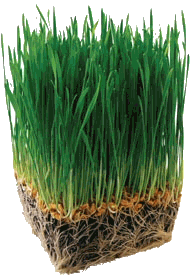The Healthiest Grasses You Could Possibly Eat (Hint: Not Your Lawn)
by SixWise.com
People have been interested in the health benefits of green
cereal grasses, the kind that will one day sprout into grains
used to make cereal, since the 1930s. It was around this time
when it was discovered that cows that didn't eat enough of
these green grasses produced milk that was less nutritious,
spurring scientists to look at these grasses' effects in humans.
|

Green grasses are a highly nutritious source of vitamins,
minerals, amino acids, chlorophyll and more, yet few
Americans take advantage of their health-promoting benefits.
|
Today, it's known that green cereal grasses contain beta-carotene,
vitamins K and C, folic acid, calcium, iron, protein, fiber,
chlorophyll and many of the B vitamins. You can find many
varieties of them in health food stores, ranging from powders
to caplets, or you can get a not-so-great-tasting "shot"
of one (usually wheat grass) in juice bars. The
healthiest grasses you can eat are barley grass, alfalfa grass,
oat grass and wheat grass.
Although the mechanisms by which these grasses promote health
are not known at this time, they've been said to fight and
prevent cancer, lower cholesterol and blood pressure, boost
the immune system, speed wound healing, promote good digestion
and healthy skin, detoxify pollutants from the body and protect
against the damaging effects of radiation.
Some of these positive effects may be due to the grasses'
high chlorophyll content, as chlorophyll is remarkably similar
to hemoglobin, the human molecule that moves oxygen through
the blood.
Barley Grass: This is "the" healthiest of
the healthy green grasses. It's rich in chlorophyll, which
has antimutagenic and anticarcinogenic properties, and enzymes,
which the body needs to perform a variety of important chemical
reactions, including those that control the body's digestive
processes. Enzymes also provide potent antioxidant effects
and energy for cells.
Dr. Yoshihide Hagiwara, M.D., who was one of the leading
experts on green barley, said green barley might contain thousands
of active enzymes, including superoxide dismutase (SOD), which
helps to detoxify the body and maintain healthy joints.
The juice from barley grass contains (per 100 grams) 11 times
more calcium than cow's milk, five times more iron than spinach
and seven times more vitamin C than oranges.
Alfalfa Grass: This is a protein-rich superfood that
contains eight essential amino acids along with vitamins A,
B, C, D, E and B12, calcium, magnesium, phosphorous, potassium,
chlorophyll and numerous trace elements. Alfalfa may help
to maintain healthy cells, reduce tissue damage from radiation
exposure, and neutralize acidity in the body, which helps
to maintain a healthy bladder and urinary tract.
Oat Grass: Like the other cereal grasses, oat grass
contains beta-carotene, vitamins K and C, folic acid, calcium,
iron, protein, fiber and B vitamins.
Wheat Grass: This grass, common in juice bars, is
a balanced source of nutrition. It contains high levels of
vitamins, minerals, amino acids, protein, enzymes, chlorophyll
and mucopolysaccharides. Further, it's known to be highly
alkalizing to the body and helps with detoxification.
How to Eat Grasses
You could, theoretically, grow your own grasses from seeds
and eat them like a leafy green. However, they're not particularly
palatable, and you would need to eat large amounts to get
high levels of nutrients. For this reason, grasses are either
juiced and taken in shots or as part of a green vegetable
juice, or consumed as a powder or pill form.
Recommended Reading
Do
You Really Need a Multivitamin Supplement?
Six
Disease-Fighting Super Antioxidants You are Likely Not Getting
Enough Of
Sources
Amazing
Grass
PDR
Health
Grainfields
Australia
Wheatgrass
and Other Cereal Grains